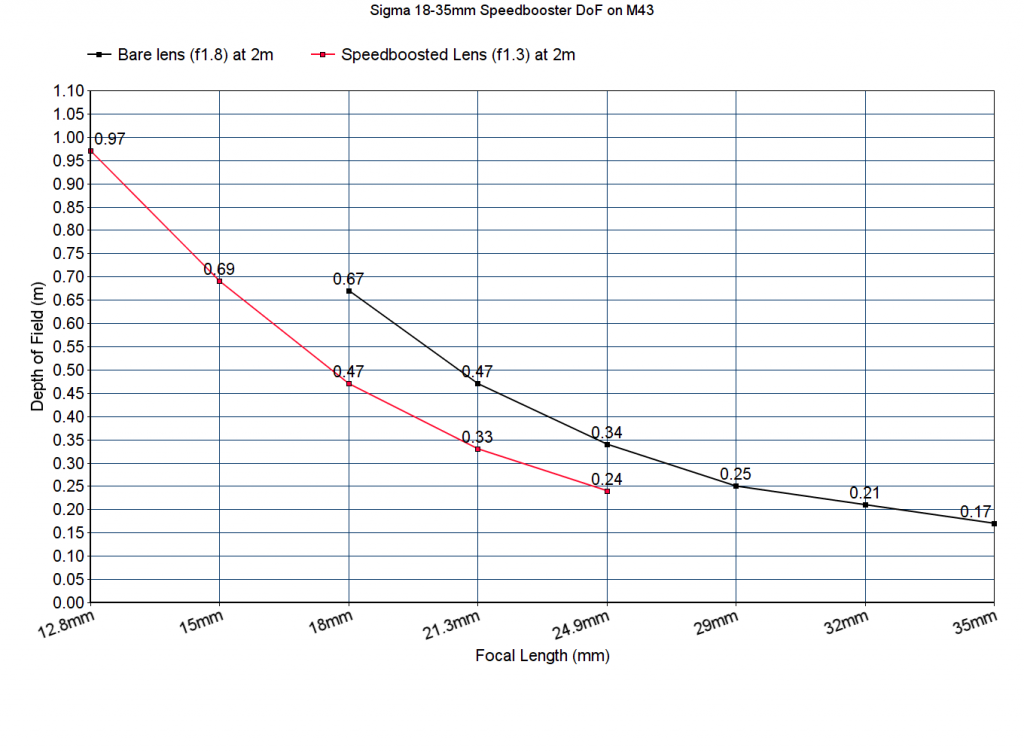I was nagged by five questions: some may have pestered you too:
1: What does a Speedbooster do? Not the obvious gains – 30% more FoV and a stop of light – but what’s the hidden penalty? What degree the degradation? Or are Speedboosters win-win? Do they really improve results for smaller sensors?
2. Is there any difference between the Mark 1 Viltrox Micro Four-Thirds adaptor for Nikon lens and the Mark 2 Viltrox adaptor for Canon EF lenses? And are there any issues doubling adaptors: ie, M42 > Canon EF > MFT?
3. Is the Sigma 18-35mm f1.8 all it’s cracked up to be? Or merely ‘good enough’ for those easily pleased? How does it compare to the Sigma 35mm f1.4 Art prime shooting in pixel shift mode?
4. The combination of Speedbooster + Sigma 18-35mm f1.8 is well trodden, but it’s not the only way to get wide angles and big apertures: how does it compare to the (expensive) Panasonic 10-25mm f1.7? Or the (cheaper) Olympus 17mm f1.2, for instance – which at 17mm strikes at the heart of the Sigma’s zoom range?
5. The Metabones Speedboosters are much more expensive than the Viltrox adaptors. Is it worth it? The growing consensus seems to be that the Mark 2 Viltrox is just about as good for less than one quarter the cost. Really?
The long version, with pictures, is in the following article, and on YouTube, but here’s the préçis:
- Even the cheap Viltrox 0.71X Speeedboster does little harm. There’s extra flare and veiling haze at the widest apertures. It significantly reduces AF efficacy. But if you start with a really good lens, results are acceptable. In some limited respects – and this is somewhat clickbait – the adapted lens may even outperform the original. But not really.
- Double-adapting to a Speedbooster is generally no problem: the Viltrox EF II had a weird vignetting issue at f2.8 (not present at f2 or f4) but there was no discernible difference optically between the Mark 1 Nikon adaptor and the Mark 2 Canon speedbooster.
- The Sigma 18-35mm is considerably sharper at f1.8 than the Art 35mm prime at f1.4. The difference holds up to f2.8 from which point on the Art prime is just as good through the range. The prime has moderate (easily corrected) barrel distortion; at 35mm, the Sigma has prominent (not easily corrected) pincushion distortion. If you crop out the corners of 4:3 for 16:9 video, the Sigma 18-35mm + Speedbooster give adequate, but not inspiring results.
- Apart from the benefit conferred by its range of focal lengths, the Speedboosted Sigma 18-35mm f1.8 (ie, 12-25mm f1.2) is significantly inferior in every respect, at every aperture, to the Olympus 17mm f1.2.
A comparison between Metabones and Viltrox adaptors is in Part 2. Meanwhile, let’s consider what the Speedbooster is doing and ensure the semantic differential of our apples and oranges are on a level playing field.
Because only the centre of our target lens’ image circle is enlarged, we don’t care about its corner sharpness. For instance, the Nikon 70-200mm VRII is very sharp centre in Zone A (the middle 6mm) at 200mm but performance rapidly degrades into the corners. The Sigma 150-600mm Contemporary doesn’t deliver a sharp corner at any aperture or focal length, but from 200-350mm, in Zone A it’s sharper wide open than stopped down. From 350-450mm it needs to be stopped down to f8 to give useable results centre frame, and from 450-600mm it’s all pretty hopeless. But knowing such things gets us serviceable results. Both these lenses can be Speedboosted quite effectively within those limits.
It’s not entirely fallacious to claim that a Speedbooster improves image quality, but the adaptor can’t take the credit. For instance, if you have a zoom that’s poor at the wide end, but peaks one third of the way through its range (and you probably do), or whose weakest point is the combination of its widest aperture and widest angle (which describes most standard wide-to-tele zooms), a Speedbooster can be a revelation. For instance, if you shoot a Tamron 24-70mm f2.8 at 24mm f2.8 on a glassless M43 adaptor, and compare it Speedboosted to the same effective angle of view and effective aperture, you will get a very rosy impression of the adaptor’s performance. However the adaptor isn’t directly responsible: it’s a corollary perk: on a standard zoom, Zone A is just much better at 35mm / f4 (becoming 24mm / f2.8 when boosted).
But if you examine the performance of the adaptor alone by fixing the lens (ie, comparing 24mm / f2.8 bare to a boosted 17mm / f2) you’ll understand the adaptor isn’t witchcraft: it’s not performing corrections: a lousy 24mm / f2.8 becomes a slightly lousier 17mm / f2. And the corners – naturally the lousiest part – are cropped away,.
Depending on your frame of comparison the Speedbooster can be a boon. But it’s important to understand that its genius lies in operational fringe benefits more than a revolution in optical design.
Similarly, consider implications of that 0.71x factor. Speedboosters have dual appeal: better light-gathering for that thirsty, noisy, little M43 sensor, and shallower DoF for that all-in-focus-dammit little M43 sensor. Extracting more light from a larger lens is a win-win: improving our ability to freeze action, and allowing us to dial back sensor amping. But I suspect more buyers have been nudged by the prospect of ‘cinematic bokeh’, and that’s a bit misleading.
Let’s take the Sigma 18-35mm f1.8 as a case in point: Speedboosted, it becomes (approximately) a 13-25mm . . . drum roll . . . f1.3! In all the excitement, let’s not overlook the fact that, in DoF terms, what we gain in effective aperture we lose in focal length: widening the lens gives us greater depth of field. How do those numbers stack up? Consider the following graph of a Sigma 18-35mm f1.8 (bare v boosted) focused on an object at a distance of two metres:

In this relatively close-up shooting situation (the better to boast of bokeh), note that the Speedboaster seeking maximum background blur, pushing the zoom to its limit (35mm becoming 24.9mm effective) and shooting at f1.3, would do just as well baring the lens and shooting at 29mm f1.8. The truly dedicated bokeh hunter is actually best served by shooting at 35mm where DoF is a sliver half that of the adapted lens.
Of course there are many scenarios in which a 35mm-equivalent 50-70mm foot zoom isn’t practical, and therein lies the major asset of the Speedbooster: it opens up wide angle options. If we try to find uses for it at the long end, it creates all the problems a teleconverter solves: limiting reach and putting us at the mercy of the weakest (always the longest) end of a tele-zoom. Still, the 2x effective multiplier of the M43 sensor gives more than it takes here, and its perfectly viable to deploy, for instance, a 200mm f2.8 35mm as a speedboosted 284mm f2 of questionable autofocus capacity on a M43 body.
While on the subject of distant objects, let’s re-run the numbers on the Sigma 18-35mm DoF calculator with an object just 6m further away:

The crucial takeaway from this chart, confirming what was said above, is what happens when you speedboost the wide end of the Sigma 18-35mm . . . you gain the precious stop, but you effectively surrender meaningful control over depth of field: shooting an object 8m away at 12mm / f1.3, almost 100m of your image is broadly in focus: you’ve hyperfocal’d yourself halfway to infinity. M43 and the laws of physics are cruel taskmasters. Note, though, that your DoF shrinks to an amenable 18.6m shooting the lens bare at 18mm / f1.8, even on M43.
Fundamentally, Speedboosted lenses – particularly the Sigma 18-35mm f1.8 – are for indoors: when space is tight, they go wide; when there’s no sun, they let in more light; when it’s a struggle to isolate near-field subjects, they blur busy backgrounds. Given space and light, though, they’re the wrong tool: for video they create the need for heavy ND filtering. They limit reach, make optical compromises and aren’t even effective at subject isolation compared to the more desirable solution of a slightly longer focal length.
Having said that, what wouldn’t a photographer give for an extra stop of light? Ultimately, that’s the Speedbooster’s inescapably silver lining.
















